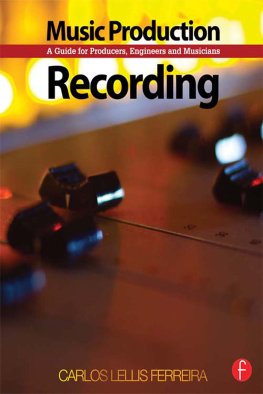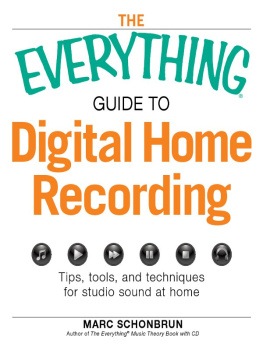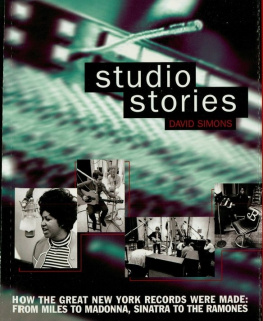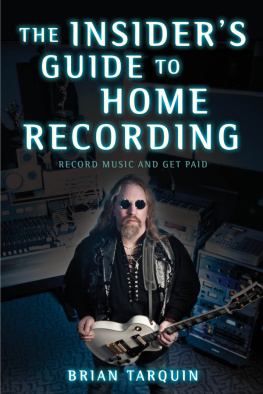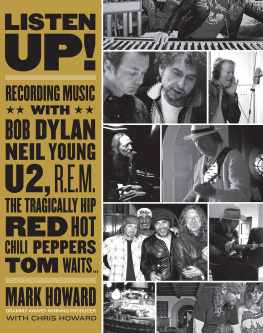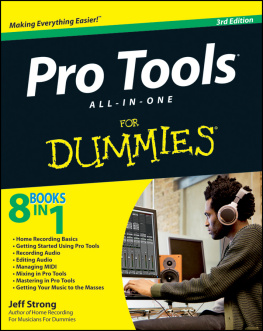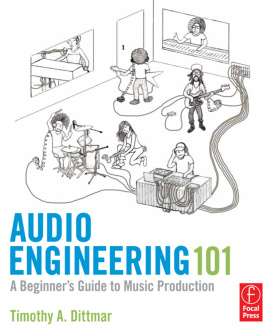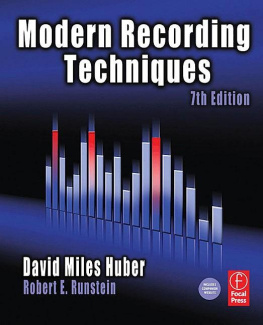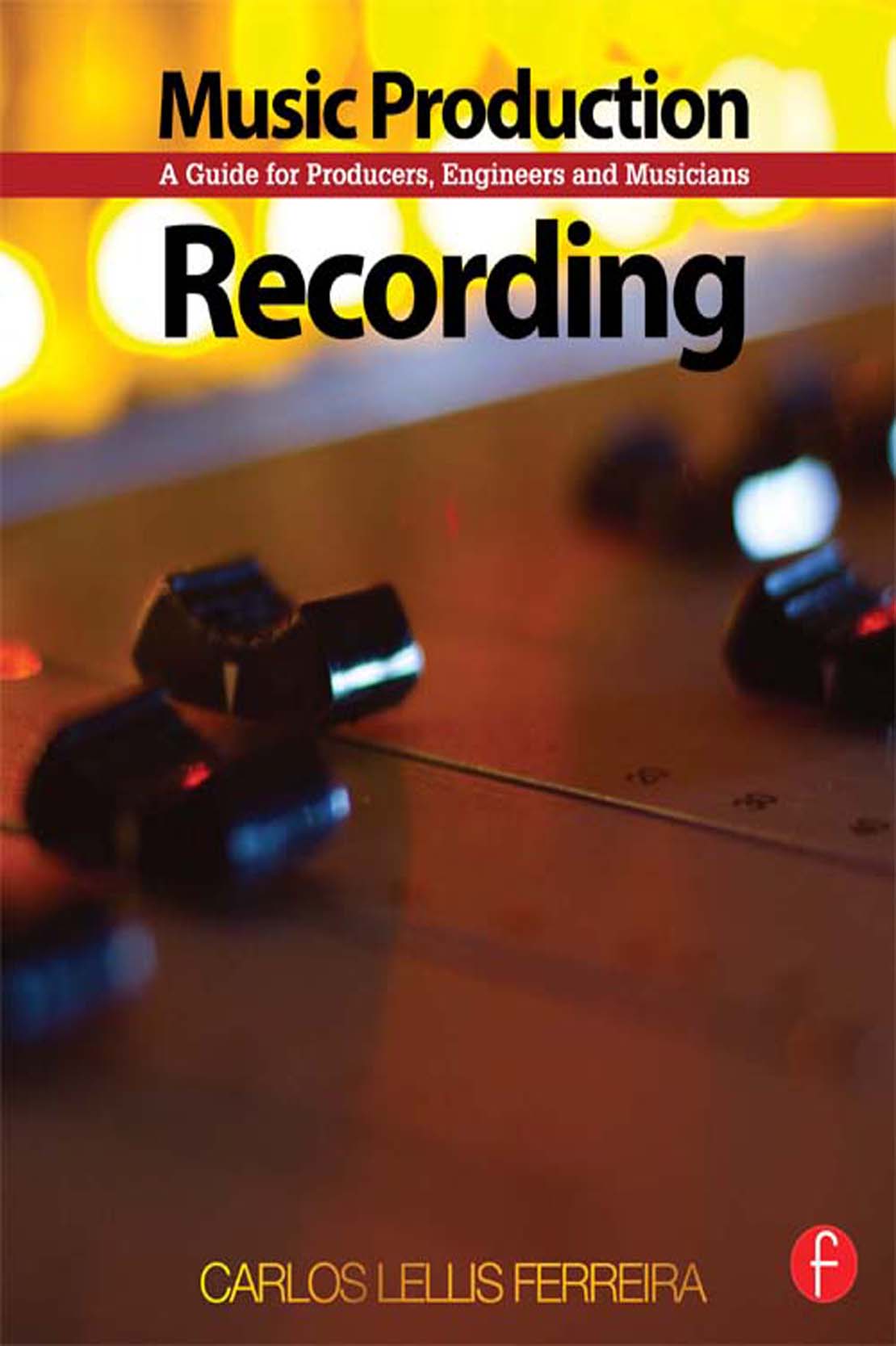MUSIC PRODUCTION: RECORDING
A Guide for Producers, Engineers and Musicians
Carlos Lellis Ferreira

First published 2013
by Focal Press
70 Blanchard Rd Suite 402
Burlington, MA 01803
Simultaneously published in the UK
by Focal Press
2 Park Square, Milton Park, Abingdon, Oxon OX14 4RN
Focal Press is an imprint of the Taylor & Francis Group, an informa business.
2013 Taylor & Francis
The right of Carlos Lellis Ferreira to be identified as author of this work has been asserted by him in accordance with sections 77 and 78 of the Copyright, Designs and Patents Act 1988.
All rights reserved. No part of this book may be reprinted or reproduced or utilised in any form or by any electronic, mechanical, or other means, now known or hereafter invented, including photocopying and recording, or in any information storage or retrieval system, without permission in writing from the publishers.
Notices
Knowledge and best practice in this field are constantly changing. As new research and experience broaden our understanding, changes in research methods, professional practices, or medical treatment may become necessary.
Practitioners and researchers must always rely on their own experience and knowledge in evaluating and using any information, methods, compounds, or experiments described herein. In using such information or methods they should be mindful of their own safety and the safety of others, including parties for whom they have a professional responsibility.
Product or corporate names may be trademarks or registered trademarks, and are used only for identification and explanation without intent to infringe.
Library of Congress Cataloging in Publication Data
Ferreira, Carlos Lellis.
Music production : recording : a guide for producers, engineers and musicians / Carlos Lellis Ferreira.
pages cm
Includes bibliographical references.
1. Popular music--Production and direction. 2. Sound recordings--Production and direction. 3. Sound--Recording and reproducing. I. Title.
ML3790.F49 2013
781.49--dc23
2012046713
ISBN: 978-0-240-52273-9 (pbk)
ISBN: 978-0-240-52274-6 (ebk)
Typeset in Century Gothic and Helvetica Neue.
Cover courtesy of Stefano Battarola, Jessie Zarazaga and SAE London.
CONTENTS
ACKNOWLEDGEMENTS
Thank you:
to Rebecca, Harley and Ella,
to the Ronchinis and the Lellis Ferreiras,
to Stefano, Jules and Jessie,
to all the musicians, engineers, producers and music industry professionals I have worked with,
to all my students past and present, for allowing me to learn with them.
NOTE
This book is comprised of different kinds of information. Some of it is what I believe recordists and producers need to know, while the rest is what I think they may choose to know. From my experience, knowledge commonly equates to confidence, a very valuable asset in music production.
The observations and suggestions presented here come from a lifetime in music. Whether performing, recording, mixing, mastering, producing or teaching I have been immersed in a musical universe from as early as I can remember.
Music has given me something to believe in and it has brought love into my life. If you feel as I do about it, then this book is dedicated to you.

FOREWORD
Soon after the author of this book and I met we both quickly realised that we shared the same passion and excitement for music and audio. Not the mad professor audio laboratory that is the mixing process, but the actual moment of audio creation, the recording process.
So how do we start in music recording? We have a drummer, sticks at the ready (silent!), guitarists have their first chord or note fretted, hand ready to strike strings, keyboard player fingers in chord shapes, ready to land on keys, vocalist, throat cleared thinking about the first note or perhaps a whole orchestra, silent, ready, watching for the conductors signal to start. In the control room, the engineers mind races through a list of all the potential problems encountered during set-up, have these all been addressed? Can the go ahead be given to start? A mental note of LEDs and meter dials that need to be watched for overload or lack of signal is made. The technical set-up time is over. A new phase begins, one of hope for the performers music to flow perfectly. Fingers are crossed for them and the technology. This is going to be it! This is going to be the one!
Recording!
Julian Jules Standen
Gearslutz.com Audio Forum
London, October 2012

THE ACT OF RECORDING
The year of 2012 marked the 135th anniversary of the invention of sound recording for reproduction and while audio technology has evolved significantly since the days of Edisons cylinder-based phonograph, the basic principles behind the act of recording have remained somewhat unchanged. To understand what makes us want to record sound, one must simply try to recall a unique moment that cannot be relived or a profound experience that cannot be replicated. Such memories make evident the natural human impulse to preserve anything that is evocative and singular. As an example, it is not uncommon for music fans to go to great lengths to record the live performances of their favourite artists in order to revisit them at a later date or to share them with absent friends.
Recording is mostly a social, collaborative activity and in this capacity it appears as more primal or instinctive than the commonly more isolated and lonelier processes of mixing and mastering.
As far as the preserving of ones own music, a passage in Wim Wenders film Until the End of the World may resonate with artists that record themselves frequently. In the aforementioned film, a scientist accidentally develops a machine that records dreams and its use becomes addictive to some of those who try it. Such individuals eventually appear to know themselves and each other more profoundly through the exchange of their recordings.
The sound recorder is the mirror with a memory for those who listen. With it we can capture glimpses of our reality, producing pictures as we express ourselves. These may ultimately serve as reminders of who we were and of our dreams.

RECORDING ENVIRONMENTS
Music is created in a multitude of environments, ranging from sophisticated and commonly expensive high-end recording studios to small bedrooms. With this in mind, serious recordists must be prepared to capture performances in any space considered suitable by music makers, including venues selected for reasons other than their sonic attributes (which may seem frustrating to those expecting to always operate under ideal circumstances).
The evaluation of a potential recording space is not simple, as a number of indirectly related and at times unpredictable factors may affect the result of sessions. In fact, in some circumstances the selection of recording settings based on emotional criteria may yield results that justify a sacrifice in sound quality, e.g. when comfort outweighs unfavourable acoustics.

